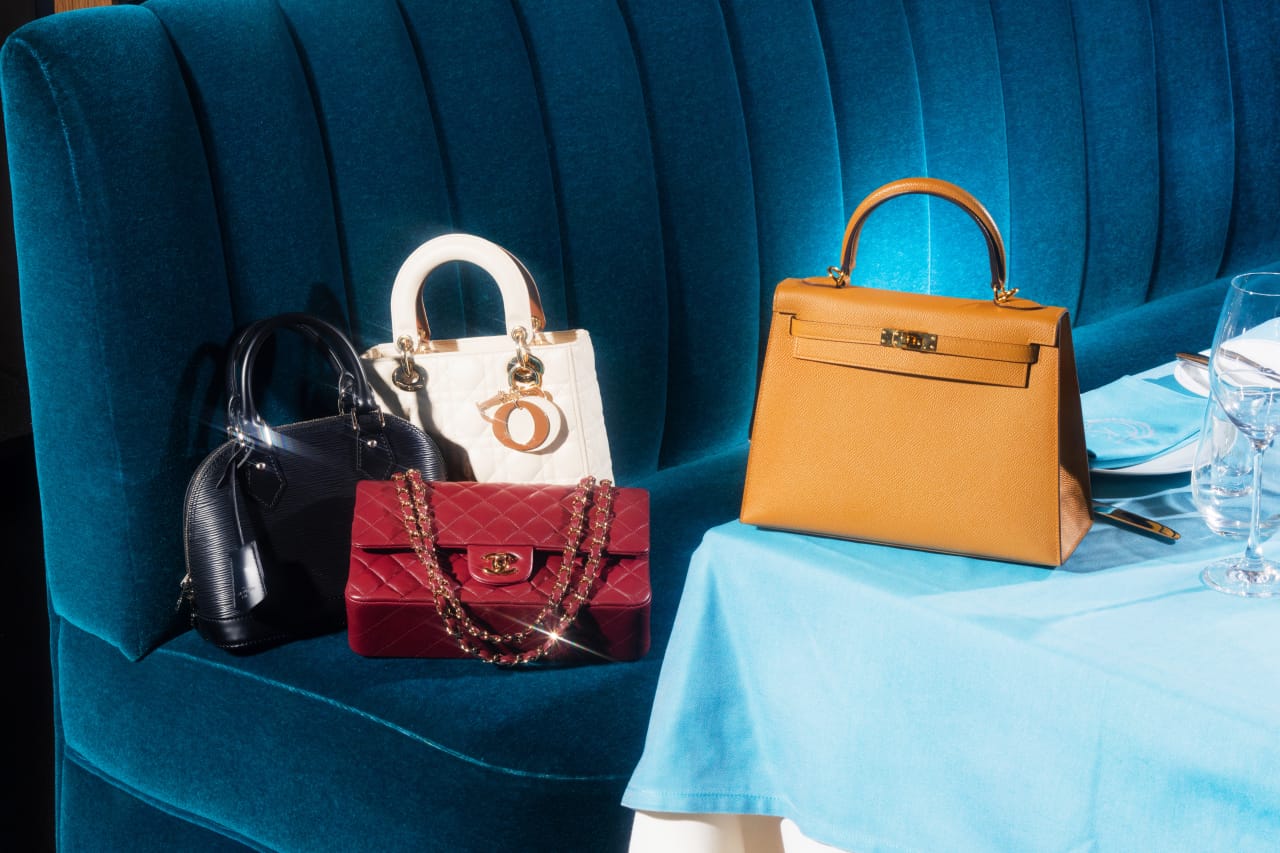Does a ‘Status Handbag’ Still Have Status in 2024? We Investigate.
Some designer handbags like the Hermès Kelly have implied power. But can a purse alone really get you a restaurant table—or even a job?
LIKE MARVEL VILLAINS, most fashion writers have origin stories. Mine began with a navy nylon Prada purse, salvaged from a Boston thrift store when I was a teen in the 1990s. Scuffed with black streaks and sagging, it was terribly beat-up. But I saw it as a golden ticket to a future, chicer self. No longer a screechy suburban theatre kid, I would revamp myself as sophisticated, arch, even aloof. The bag, I reasoned, would lead the way.
That fall, I slung it against my shoulder like a shotgun and marched into school, where a girl far more interesting than I was called out, “Hey, cool bag.” After feigning apathy —“I don’t know, you could use a Sharpie on a lunch bag and it would look the same”—we became friends. She introduced me to a former classmate who worked at a magazine. That woman helped me get an internship, which led to a job.
Twenty years later, I still wonder how big of a role that Prada purse played in my future—and whether designer bags can function as a silent partner in our success. Branded luxury bags took off in 1957, when Grace Kelly posed with an Hermès bag in Life magazine. (Hermès renamed that bag “the Kelly” in 1973.) The term “status bag” was popularised in 1990 by Gaile Robinson in the Los Angeles Times, describing any purse that projects social or economic power. Not surprisingly, these accessories are costly. Kelly bags cost over $10,000; ditto Chanel’s 11.22 handbag. Some bags by Louis Vuitton and Dior command similar price points. The cost isn’t repelling customers—both brands reported revenue surges in 2023. But isn’t there something dusty about the idea that a branded bag carries meaning along with your phone and wallet? How much status can a status bag deliver in 2024?
Quite a lot, said Daniel Langer, a business professor at Pepperdine University and the CEO of Équité, a Swiss luxury consulting firm. Beginning in 2007, Langer showed a series of photo portraits to hundreds of people across Europe, Asia and the U.S., then asked them 60 questions. Those pictured carrying a luxury handbag were seen as “more attractive, more intelligent, more interesting,” he said. The conclusion was “so ridiculous” to Langer that he repeated the studies several times over the next decade and a half. The results were always the same: “Purchasing a ‘status bag’ will prepare you to be more successful in your social actions. That is the data.”
Intrigued, I gathered various Very Important Purses—I borrowed some from friends, and others from brands—to see if they could elevate my station with the same unspoken oomph as a “Pride and Prejudice” suitor.
First, I took Alaïa’s Le Teckel bag—a narrow purse resembling an elegant flute case and carried by actress Margot Robbie—to New York’s Carlyle Hotel on a Saturday night. The line for the famous Bemelmans Bar stretched to the fire exit. “Can I get a table right away?” I asked the host, holding out my bag like a passport before an international flight. “It’s very busy,” he said in hushed tones. “But come sit. A table should open soon.” I sank into one of the Carlyle’s lush red sofas and sipped a martini while waiting—a much nicer way to kill 30 minutes than slumped against a lobby wall.
Wondering if this was a one-time thing, I called up Desta, the mononymous “culture director” (read: gatekeeper) who has worked for Manhattan celebrity hide-outs like Chapel Bar and Boom, the Standard Hotel bar that hosts the Met Gala’s official after party. “Sure, we pay attention to bags,” he said. “Not too long ago at Veronika,” the Park Avenue restaurant where Desta also steered the social ship, “we had one table left. A woman had a Saint Laurent bag from the Hedi Era,” he said, referencing Hedi Slimane , the brand’s revered designer from 2012 to 2016. “I said, ‘Give her the table. She appreciates style. She’ll appreciate this place.’”
Some say a status bag can open professional doors, too. Cleo Capital founder Sarah Kunst, who lives between San Francisco and London, notes that in private-equity circles, these accessories can act as a quick head-nod in introductory situations. Kunst says that especially as a Black woman, she found a designer bag to be “almost like armour” at the beginning of her career. “You put it on, and if you’re walking into a work event or a happy hour where you need to network, it can help you fit in immediately.” She cites Chanel flap bags made from the brand’s signature quilted leather and stamped with a double-C logo as an industry favourite. “People love to talk about them. They’ll say, ‘Ohhh, I love your bag,’ in a low voice.” They talk to you, said Kunst, “like you’re a tiger.”
For high-stakes jobs that rely on commissions—sports agents or sales reps, for instance—a fancy handbag can help establish credibility. “It says, ‘I’m succeeding at my job,’” said Mary Bonnet, vice president of the Oppenheim Group, the California real-estate firm at the centre of Netflix reality show “Selling Sunset.” As a new real-estate agent in her 20s, Bonnet brought a fake designer bag to a meeting. To her horror, a potential buyer had the real thing. “I work in an industry where trust is important, and there I was being inauthentic. That was a real lesson.” Now Bonnet rotates several (real) Saint Laurent and Chanel bags, but notes that a super-expensive purse could alienate some clients. “I don’t think I’d walk into [some client homes] with a giant Hermès bag.”
Hermès bags are supposedly the apex predator of purses. But I didn’t feel invincible when I strapped a Kelly bag around my chest like a pebbled-leather ammo belt. The dun-brown purse cost $11,800, a sum that prompted my boyfriend to ask if I needed a bodyguard. Shaking with “is this insured?” anxiety, I walked into a showing for an $8.5 million apartment steps from Central Park. I made it through the door but was soon stopped by a gruff real-estate agent asking if I had an appointment. No, but I had an Hermès bag? Alas, it wasn’t enough. The gleaming black door closed in my face.
“What went wrong?” I asked Dafna Goor, a London Business School professor who studies the psychology behind luxury purchases. “You felt nervous,” she replied. “That always makes others uncomfortable, especially in a high stakes situation,” like an open house with jittery agents. Goor said recognisable bags from Louis Vuitton and Christian Dior are also often faked, which can lead to suspicion if not paired with “other signals of wealth.”
“You can’t just treat a bag as a backstage pass,” said Jess Graves, who runs the shopping Substack the Love List. Graves says bags are more of a secret code shared between potential connections. “I’ve been in line for coffee and a woman will see my Margaux [from the Row] and go, ‘Oh, I know that bag.’ Then we’ll chat.” Graves moved from Atlanta to Manhattan in 2023, and says she’s made some new, local friends thanks to these “bag chats.”
I had my own bag chat that night, when I brought Khaite’s Olivia—a slim crescent of shiny maroon leather—to a house party thrown by a rock star I’d never met. In fact I knew hardly any guests, but as I stood in the kitchen, a woman in vintage Chanel pointed to my bag and asked, “How did you get that colour? It’s sold out!” Before I could tell her my name, she told me the make and model of my purse. Then she laughed about her ex-boss, a tech billionaire, and encouraged me to buy some cryptocurrency. The token I picked surged nearly 30% in about a week. Now I was onto something—a status bag that might bring not just status, but an actual market return.
Thanks to their prominence on social media, certain bags have gained favour among Gen Zers. “TikTok and Instagram make some luxury items even more visible and more desirable to young people,” said Goor. I experienced this firsthand on a stormy Saturday morning, when a girl in a college hoodie pointed at my Miu Miu Wander bag as I puddle-hopped through downtown New York. The piglet-pink purse is a TikTok favourite seen on young stars like Sydney Sweeney and Hailey Bieber. “Your bag is everything!” yelled the girl from the crosswalk. “Thanks, can I have your umbrella?” I shouted back. She laughed and left. My Wander had made a splash—but it couldn’t keep me dry. I ran to the subway, soaked. The bag looked even better wet.
Changing the Status Bag Quo
Everyone loves an ingénue—fashion insiders included. Perhaps that’s why at Paris Fashion Week in September, newer handbags from Bottega Veneta and Loewe jostled for space and street-style flashbulbs.
“These bags, especially ones by independent labels like Khaite, are quieter signals of cultural access,” explained Goor. “Everyone knows what an Hermès Kelly bag is. So now there need to be new signals” beyond traditional status bags to convey power.
Sasha Bikoff Cooper, a Manhattan interior designer, says there’s a less cynical explanation for why these bags have captured celebrity fans—and more important, paying customers. “They’re fresh and also beautiful,” she said. “Hermès is always classic. It’s like a first love. But you want newness, too.”
The Wall Street Journal is not compensated by retailers listed in its articles as outlets for products. Listed retailers frequently are not the sole retail outlets.
 Copyright 2020, Dow Jones & Company, Inc. All Rights Reserved Worldwide. LEARN MORE
Copyright 2020, Dow Jones & Company, Inc. All Rights Reserved Worldwide. LEARN MORE
Records keep falling in 2025 as harbourfront, beachfront and blue-chip estates crowd the top of the market.
A divide has opened in the tech job market between those with artificial-intelligence skills and everyone else.
JPMorgan Chase has a ‘strong bias’ against adding staff, while Walmart is keeping its head count flat. Major employers are in a new, ultra lean era.
It’s the corporate gamble of the moment: Can you run a company, increasing sales and juicing profits, without adding people?
American employers are increasingly making the calculation that they can keep the size of their teams flat—or shrink through layoffs—without harming their businesses.
Part of that thinking is the belief that artificial intelligence will be used to pick up some of the slack and automate more processes. Companies are also hesitant to make any moves in an economy many still describe as uncertain.
JPMorgan Chase’s chief financial officer told investors recently that the bank now has a “very strong bias against having the reflective response” to hire more people for any given need. Aerospace and defense company RTX boasted last week that its sales rose even without adding employees.
Goldman Sachs , meanwhile, sent a memo to staffers this month saying the firm “will constrain head count growth through the end of the year” and reduce roles that could be more efficient with AI. Walmart , the nation’s largest private employer, also said it plans to keep its head count roughly flat over the next three years, even as its sales grow.
“If people are getting more productive, you don’t need to hire more people,” Brian Chesky , Airbnb’s chief executive, said in an interview. “I see a lot of companies pre-emptively holding the line, forecasting and hoping that they can have smaller workforces.”
Airbnb employs around 7,000 people, and Chesky says he doesn’t expect that number to grow much over the next year. With the help of AI, he said he hopes that “the team we already have can get considerably more work done.”
Many companies seem intent on embracing a new, ultralean model of staffing, one where more roles are kept unfilled and hiring is treated as a last resort. At Intuit , every time a job comes open, managers are pushed to justify why they need to backfill it, said Sandeep Aujla , the company’s chief financial officer. The new rigor around hiring helps combat corporate bloat.
“That typical behavior that settles in—and we’re all guilty of it—is, historically, if someone leaves, if Jane Doe leaves, I’ve got to backfill Jane,” Aujla said in an interview. Now, when someone quits, the company asks: “Is there an opportunity for us to rethink how we staff?”
Intuit has chosen not to replace certain roles in its finance, legal and customer-support functions, he said. In its last fiscal year, the company’s revenue rose 16% even as its head count stayed flat, and it is planning only modest hiring in the current year.
The desire to avoid hiring or filling jobs reflects a growing push among executives to see a return on their AI spending. On earnings calls, mentions of ROI and AI investments are increasing, according to an analysis by AlphaSense, reflecting heightened interest from analysts and investors that companies make good on the millions they are pouring into AI.
Many executives hope that software coding assistants and armies of digital agents will keep improving—even if the current results still at times leave something to be desired.
The widespread caution in hiring now is frustrating job seekers and leading many employees within organizations to feel stuck in place, unable to ascend or take on new roles, workers and bosses say.
Inside many large companies, HR chiefs also say it is becoming increasingly difficult to predict just how many employees will be needed as technology takes on more of the work.
Some employers seem to think that fewer employees will actually improve operations.
Meta Platforms this past week said it is cutting 600 jobs in its AI division, a move some leaders hailed as a way to cut down on bureaucracy.
“By reducing the size of our team, fewer conversations will be required to make a decision, and each person will be more load-bearing and have more scope and impact,” Alexandr Wang , Meta’s chief AI officer, wrote in a memo to staff seen by The Wall Street Journal.
Though layoffs haven’t been widespread through the economy, some companies are making cuts. Target on Thursday said it would cut about 1,000 corporate employees, and close another 800 open positions, totaling around 8% of its corporate workforce. Michael Fiddelke , Target’s incoming CEO, said in a memo sent to staff that too “many layers and overlapping work have slowed decisions, making it harder to bring ideas to life.”
A range of other employers, from the electric-truck maker Rivian to cable and broadband provider Charter Communications , have announced their own staff cuts in recent weeks, too.
Operating with fewer people can still pose risks for companies by straining existing staffers or hurting efforts to develop future leaders, executives and economists say. “It’s a bit of a double-edged sword,” said Matthew Martin , senior U.S. economist at Oxford Economics. “You want to keep your head count costs down now—but you also have to have an eye on the future.”
A luxury lifestyle might cost more than it used to, but how does it compare with cities around the world?
When the Writers Festival was called off and the skies refused to clear, one weekend away turned into a rare lesson in slowing down, ice baths included.
























